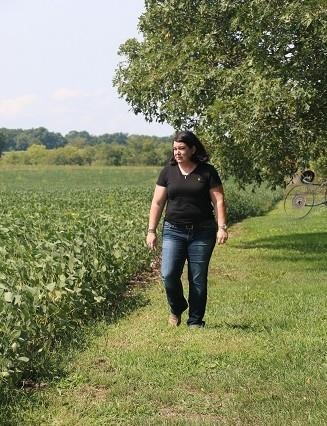By Wendong Zhang and Madeline Schultz
Nearly 360 women landowners in Iowa shared their experiences on owning and operating farmland in a recent survey conducted by Iowa State University Extension and Outreach.
A study in 2017 showed that women own nearly half of the farmland in Iowa, and specialists with ISU Extension and Outreach wanted to improve their understanding of this important segment of the state’s agriculture.

The current survey asked women landowners a variety of questions related to farmland leasing, conservation practices, and farmland transition plans. According to the results, a majority of women are interested in information about landowner responsibilities, the economics of farmland ownership, crop production costs, and determining the right rental rates.
The survey also shows how women prefer to receive farmland management information, with the majority preferring newsletters, followed by webinars, fact sheets and infographics, and half-day educational meetings.
“The survey sort of serves as the basis for trying to understand what women landowners want to know both in terms of content but also how they would like to receive information,” said Wendong Zhang, one of the survey leads and an extension economist at Iowa State University. “The goal is to better match our resources that we can offer at Iowa State and other land grant universities to better inform and help empower women landowners, regardless of their location and experience.”
The survey is part of a larger project partially funded by a grant from the United States Department of Agriculture’s National Institute of Food and Agriculture and Farm Credit Services of America. The goal is to improve the knowledge and confidence of women landowners on the use of more equitable farmland leases, the adoption of soil and water conservation practices and the implementation of efficient plans to transition farmland to the next generation.
The survey was sent to 688 landowners in the fall of 2021 and completed by 358 women for a response rate of 52%.
“There were some very interesting findings that differentiated the operating landowners and the non-operating landowners,” said Madeline Schultz, program manager for Women in Ag with ISU Extension and Outreach.
Schultz said it’s particularly noteworthy that most women in the survey lease out at least a portion of their farm, and that nearly a quarter of respondents lease their land to someone other than a friend or family member.
“This shows there are opportunities for others to lease land – potentially a beginning farmer or someone else from a younger generation,” said Schultz.
The survey also compares women landowners by age, size of operation and operator versus non-operator status.
More than 80% of owners rely primarily on their tenants to make decisions on crop varieties and inputs, and 65% of owners report that tenants manage the tillage practices. Some 34% of operating owners and 85% of non-operating owners lease at least a portion of their land.
“Farmland leasing is very much of interest to women in agriculture and a majority of participants in the current farm management meetings across Iowa are men,” said Schultz. “With women showing this level of interest, we would love to get more women to participate in those meetings.”
The survey also shows which conservation issues women are most worried about. Most (69%) say they are concerned there are too many requirements and restrictions and too much paperwork associated with government conservation programs. Interference with the ability to change land management practices (57.6%), low cost-share payments (54.4%), and limited environmental value of the practices (51.5%) are also important concerns.
In addition to Zhang and Schultz, the survey was supported by Kristine Tidgren, Catherine DeLong, Jamie L. Benning, Melissa O’Rourke, Lisa Scarbrough, Cory Hyde, and Jingyi Tong (graduate student).
The results will be used in the months and years ahead as ISU Extension and Outreach continues to improve its face-to-face opportunities for women in agriculture and methods of educational delivery.
Source : iastate.edu